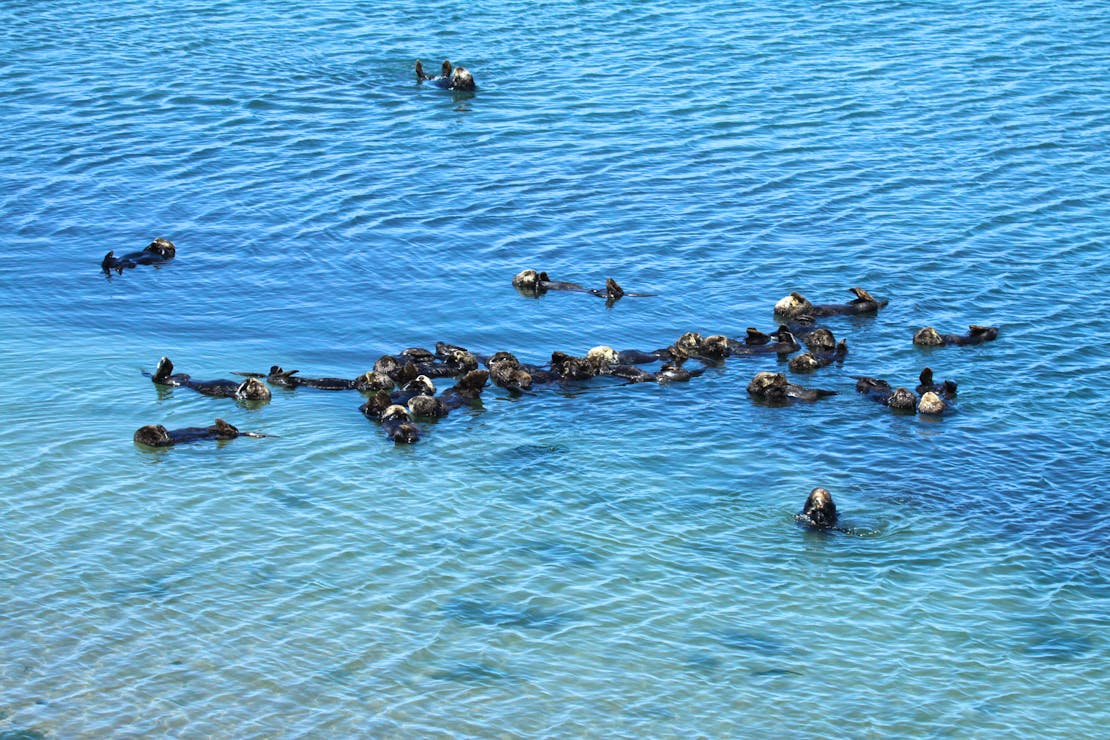A year ago, as a new hire at Defenders, I took the opportunity on World Otter Day 2020 to introduce myself and share the various ways that Defenders would be working to expand our involvement in sea otter conservation. Now it’s World Otter Day 2021, and as a grizzled Defenders veteran—well, I was pretty grizzled before I came to Defenders—I feel as though we’ve gathered momentum with our sea otter programs and can participate in meaningful ways to protect these animals throughout their full range.
Of course, World Otter Day celebrates all 13 species of otter, from the diminutive Asian small-clawed otter of Malaysia to the giant otter of Brazil and the North American river otter to the sea otter in the North Pacific. As apex predators within the various environments they inhabit, sea otters and river otters help establish diversity within those ecosystems. But all otter species remain challenged by human activity. Human-caused climate change alters prey availability for otters, our commercial activities—shipping, farming, fishing, trucking, etc.—crisscross and pollute otter habitat, and our recreational activities can disturb or displace otters. If we intend to live in relative harmony with otters and other wildlife, we need to recognize and appreciate what they need to survive, how we make their lives more challenging and when we cause them harm.
In Southeast Alaska, the U.S. Fish and Wildlife Service (FWS) has established a sea otter stakeholder working group to develop a plan for managing identified conflicts among sea otters and commercial and Tribal shellfish operations in the region. This group will focus on sea otter coexistence conflicts in Southeast Alaska. Joining the group is Defenders’ Alaska Marine Representative, Katy Bear Nalven, she will bring her energy, creativity and reasoned ideas in service of sea otters!
We’ve also started engaging in a more direct way with the Elakha Alliance to evaluate the ecological and economic feasibility of reintroducing sea otters to Oregon. Defenders’ Northwest program director Kathleen Gobush has joined Elakha’s advisory council to offer guidance and review the alliance’s scientific work. Defenders has a keen interest in seeing sea otters restored to the waters of northern California and all of Oregon, where they have been absent for more than a century. Kathleen and her teammate Sristi Kamal also hope to conduct community- and decision-maker outreach on the restoration concept and the important role sea otters play in maintaining biodiverse marine and nearshore ecosystems.
Because the pandemic restricted in-person gatherings, to continue sea otter protection and management discussions, Defenders and our partners at Sea Otter Savvy and FWS organized a virtual Southern Sea Otter Alliance Meeting in January. The two-day session allowed this group to reconnect, exchange updates, review research opportunities and discuss recovery strategies for sea otters in California.
Defenders also planned and hosted the 2021 Sea Otter Research and Conservation Symposium with the Seattle Aquarium in early April. This two-day symposium brought together hundreds of sea otter biologists, agency managers, veterinarians, advocates, technicians, academics, caregivers and graduate students—in essence, the worldwide sea otter conservation community—to hear the latest about sea otter demographics, health, ecology, genetics, management and outreach. To make sure that we tempered our serious work with a bit of fun, Defenders hosted an evening event called “Paint a Sea Otter,” and an artist instructed attendees via Zoom how to create their own sea otter painting. (I’d say the event was more fun than a barrel of otters, but given the snarly nature of these sea weasels, that wouldn’t be much fun at all.) The artist’s example and few of the finished paintings appear below.






Today also marks the launch of Defenders’ Sea Otter Group on Facebook. We encourage everyone who has an interest in sea otters and who supports Defenders of Wildlife’s mission to protect native plants and animals to join the group. We’ll keep group members up-to-date on sea otter conservation issues, the status of populations (such as the results from the 2021 California sea otter census, which began the first week of May) and the latest science news. We’ll also share fun stories, images and videos, answer questions and promote upcoming events—like World Otter Day and Sea Otter Awareness Week!
Now that I’ve mentioned it, we’re starting to plan Sea Otter Awareness Week (SOAW) for 2021 along with our partners at Sea Otter Savvy and California Department of Parks and Recreation. This year’s theme follows the idea of the sea otter’s ecosystem as a mosaic in which the removal of key elements or damage to the system’s structure renders the ecological picture incomplete. We will populate our SOAW web page with events and activities throughout the summer months, so check the site often as September approaches and make a plan to celebrate sea otters from September 19 – 25.
But while we celebrate sea otters during awareness week in September, World Otter Day offers us another excuse to assess our work on behalf of sea otters and to think about the effect we have on all wildlife and wild places. We’re doing all we can to ensure that keystone species, like the otter, flourish and continue making ecosystems more diverse and resilient.










